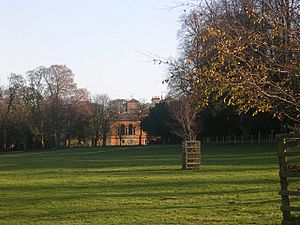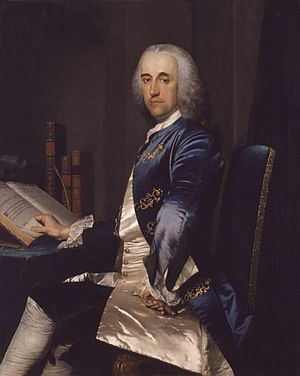Sir Thomas Robinson, 1st Baronet facts for kids
Sir Thomas Robinson, 1st Baronet (1703–1777) was an important English person from Rokeby Park in Yorkshire. He was a politician in the House of Commons from 1727 to 1734. He also served as a Governor of Barbados. Sir Thomas was known for being an architect and a collector of interesting things. He loved to spend money and was famous for his many interesting stories.
Contents
Early Life and Travels
Sir Thomas Robinson was born in 1703. His father was William Robinson, and his mother was Anne Walters. His younger brother, Richard, later became an important church leader called the Archbishop of Armagh.
After finishing his schooling, Thomas went on a long trip around Europe called the Grand Tour. He spent a lot of time in Greece and Italy, where he studied architecture. He was especially interested in the style of a famous architect named Palladio. When he came back to England, he joined the army for a short time before giving his position to his brother.
Politics and Building Projects
In 1727, Sir Thomas became a Member of Parliament for a town called Morpeth. He supported the government at the time.

In 1731, the King made him a "Baronet." This was a special title that meant he was a knight, and the title could be passed down in his family.
Sir Thomas loved to spend money, especially on building and parties. He rebuilt his family home, Rokeby Hall, and changed its name from Rookby. He also built a stone wall around the park and planted many trees. These projects made the area look beautiful. Later, the famous writer Sir Walter Scott wrote a poem about Rokeby.
In London, Sir Thomas was famous for throwing big parties and balls. He invited many important and fashionable people. These parties were very expensive and cost him a lot of money.
Time in Barbados
Because he spent so much money, Sir Thomas had to leave England for a while. In 1742, he became the Governor of Barbados, a British colony in the Caribbean.
When he arrived in Barbados, he had some problems. The local assembly (a group of elected officials) did not want to pay his salary. He also started building new things, like an armoury (a place to store weapons), without asking them first. He ended up paying for most of these projects himself.
Sir Thomas also argued with the assembly about who should be in charge of the island's military. Because of all these disagreements, he was called back to England in 1747.
Later Life and Interests
When Sir Thomas returned to Britain, he continued to host grand parties and breakfasts. He became involved with the Royal Society of Arts in 1755, helping with its activities.
He also bought shares in Ranelagh Gardens, a popular place for entertainment in London. He became a director there, using his knowledge of fashionable society to plan events. He even built a house next to the gardens called Prospect Place.
In 1769, Sir Thomas had to sell Rokeby Park, his family home for many years, because of his money problems. Towards the end of his life, he became blind.
Death and Legacy
Sir Thomas Robinson died in 1777 at the age of 76. He was buried in a church in Merton, and a monument was placed there to remember him. Another monument was put in Westminster Abbey.
People remembered Sir Thomas as a charming but sometimes superficial person. He was very tall and thin.
Sir Thomas designed the west wing of Castle Howard for his wife's brother. He also designed parts of other buildings, like the new church at Glynde and the Gothic gateway at Auckland Castle.
He left his title to his brother William. His other brother, Lord Rokeby, received his collection of books, especially those about architecture.
Sir Thomas kept many letters from his friend Lord Chesterfield. He wanted them to be published after he died, but his brother, the Archbishop, stopped it from happening.
Family Life
In 1728, Sir Thomas married Elizabeth Howard. She was the daughter of the Earl of Carlisle. Elizabeth died in 1739.
While he was in Barbados, Sir Thomas married a second wife, whose last name was Booth. She was a wealthy widow. However, she decided not to return to England with him.



